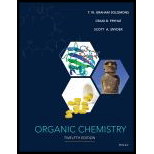
Concept explainers
Interpretation:
The reason for the susceptibility of nucleosides to acidic hydrolysis and the mechanism of this hydrolysis is to be explained.
Concept introduction:
舧 Electrophiles are electron-deficient species, which has positive or partially positive charge. Lewis acids are electrophiles, which accept electron pair.
舧 Nucleophiles are electron-rich species, which has negative or partially negative charge. Lewis bases are nucleophiles, which donate electron pair.
舧 A nucleoside consists of a nucleobase (also termed as nitrogenous base) and a five-carbon sugar (either ribose or deoxyribose).
舧 A
舧 In a nucleoside, the anomeric carbon is linked through a glycosidic bond to the N9 of a purine or N1 of a pyrimidine.
舧 Examples of nucleosides include cytidine, uridine, adenosine, guanosine and thymidine.
舧 Sugar (ribose/deoxyribose) and nitrogenous bases are linked through N-glycosidic bonds.
舧 These glycosidic bonds are formed by condensation reaction of first carbon of sugar molecule with the nitrogen atom
舧 This particular glycosidic bond is stable in basic solutions, but readily hydrolyzes in the presence of acids.
Want to see the full answer?
Check out a sample textbook solution
Chapter 25 Solutions
EBK ORGANIC CHEMISTRY
- (iii)How many different trinucleotide can be formed by combining the nucleotide bases ATG? Each trinucleotide must contain one of each baseHINT;One combination is A-T-G.arrow_forwardGive the sequence of the following tetrapeptide:arrow_forwardDraw the formula of each of the following tripeptides: (a)Aspartic acid- histidine- tryptophan (b) Glycine- cysteine with the charges that exist in the cell fluid (c) Lysine-phenylalanine- threonine (d)Alanine- leucine- valine with the charges that exist in fluidarrow_forward
- (a) Redraw the tripeptide in zwitterionic form (b) Explain how ESI-MS can be used to determine which amino acid is in the middle of the sequence.arrow_forwardResearchers analysed a glycopeptide (a peptide carrying one or several oligosaccharide groups) and determined both the sequence of the peptide and the sequence of the sugar molecule. The latter was identified as a diholoside coupled to the peptide by an osidic bond. The systematic name of this sugar is: B-D-glucopyranosyl-(1→4)-ß-D-galactopyranose. : Represent the chemical formula of this diholoside in a way that all oses are Question 1 represented according to the Haworth convention. Apart from the furane and/or pyrane cycles all atoms of this molecule must be given.arrow_forwardCH2023 Q3 (a)arrow_forward
- Identify monomeric and multimeric (di-,tri-meric, for example) saccharides from this group. If you come across multimeric polypeptides, state the mono- mers that form these multimers. State the nature of the bond that links two units together in each case. (a) Maltose (b) Trehalose (c) Lactose (d) Sucrose (e) Cellobiose (f) Agarosearrow_forwardDuring base excision repair, DNA glycosylase cleaves theN-glycosidic link between the altered base and the deoxyribose component of the nucleotide. Draw a typical nucleotideand indicate which bond is cleaved.arrow_forwardCH2023 Q2 (b)arrow_forward
- Exposure to nitrous acid (see Section 19-16), sometimes found in cells, can convert cytosine to uracil.(a) Propose a mechanism for this conversion.(b) Explain how this conversion would be mutagenic upon replication.(c) DNA generally includes thymine, rather than uracil (found in RNA). Based on this fact, explain why the nitrous-acidinduced mutation of cytosine to uracil is more easily repaired in DNA than it is in RNA.*arrow_forwardGlucose is an aldose sugar but it does not react with sodium hydrogensulphite. Give reason.arrow_forwardThe anticlotting property of heparin is partly the result of the negative charges it carries. ( Q.) Identify the functional groups that provide the negative charges.arrow_forward
 Chemistry for Today: General, Organic, and Bioche...ChemistryISBN:9781305960060Author:Spencer L. Seager, Michael R. Slabaugh, Maren S. HansenPublisher:Cengage Learning
Chemistry for Today: General, Organic, and Bioche...ChemistryISBN:9781305960060Author:Spencer L. Seager, Michael R. Slabaugh, Maren S. HansenPublisher:Cengage Learning

